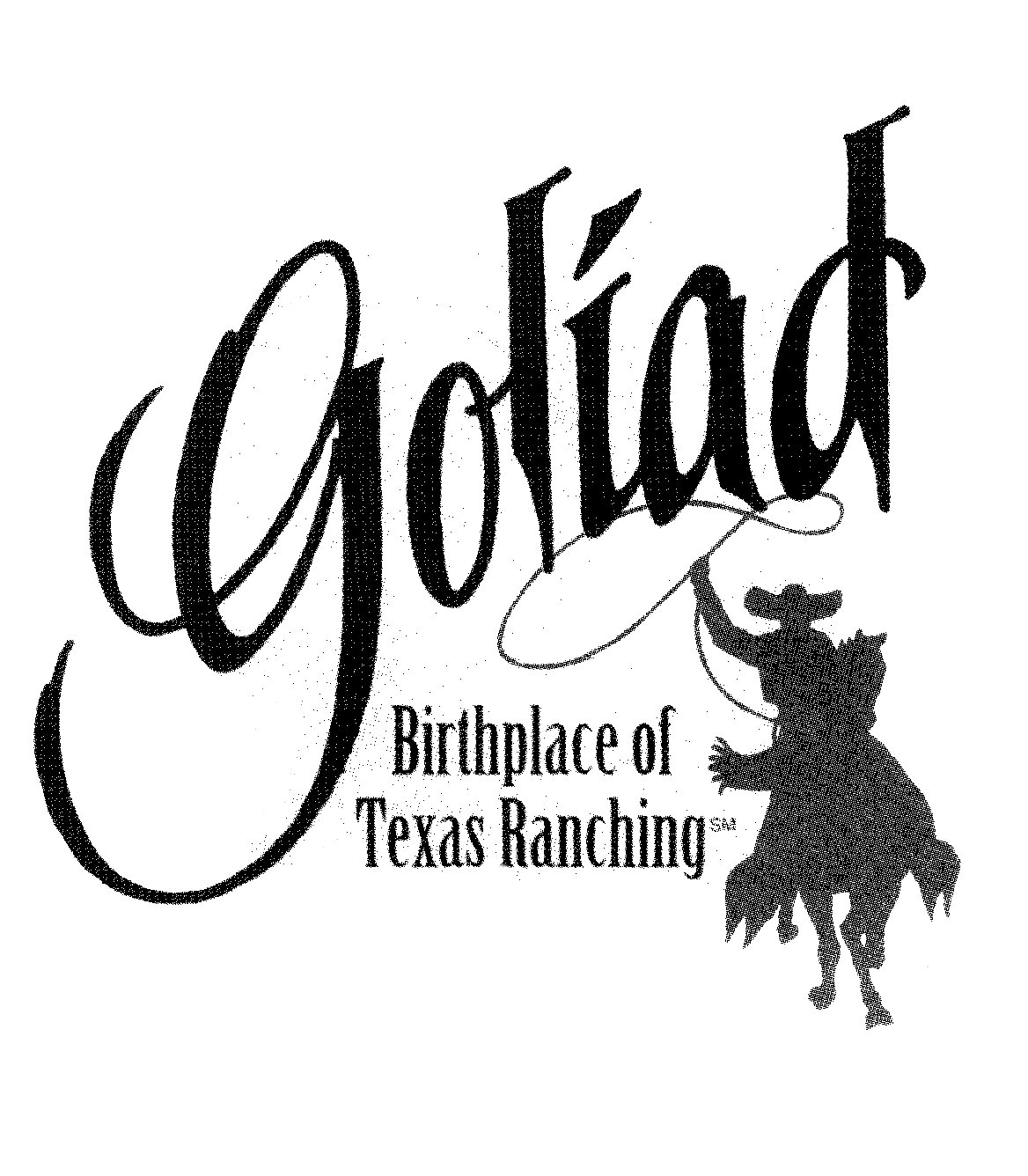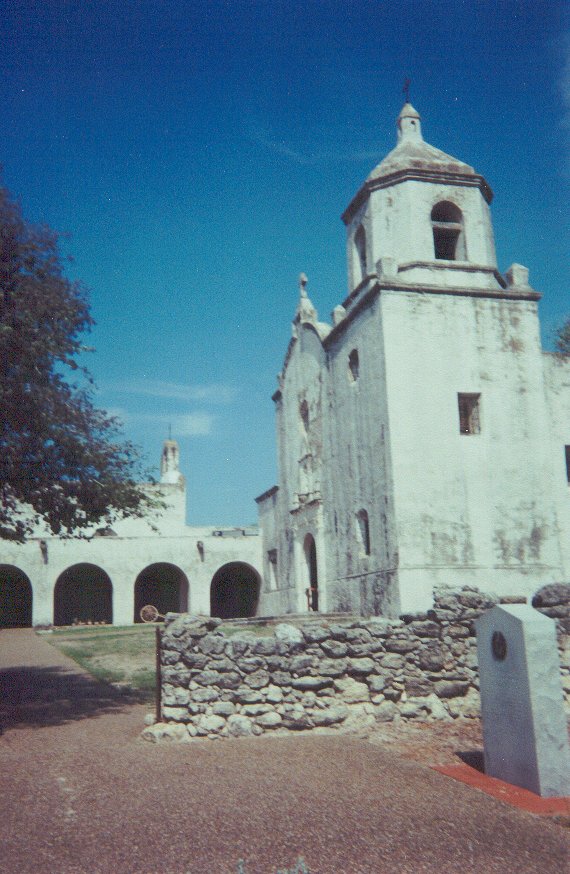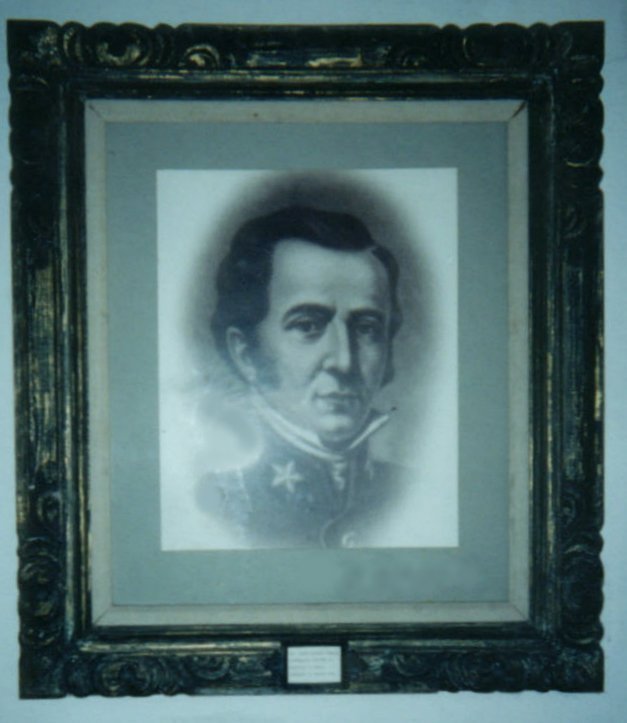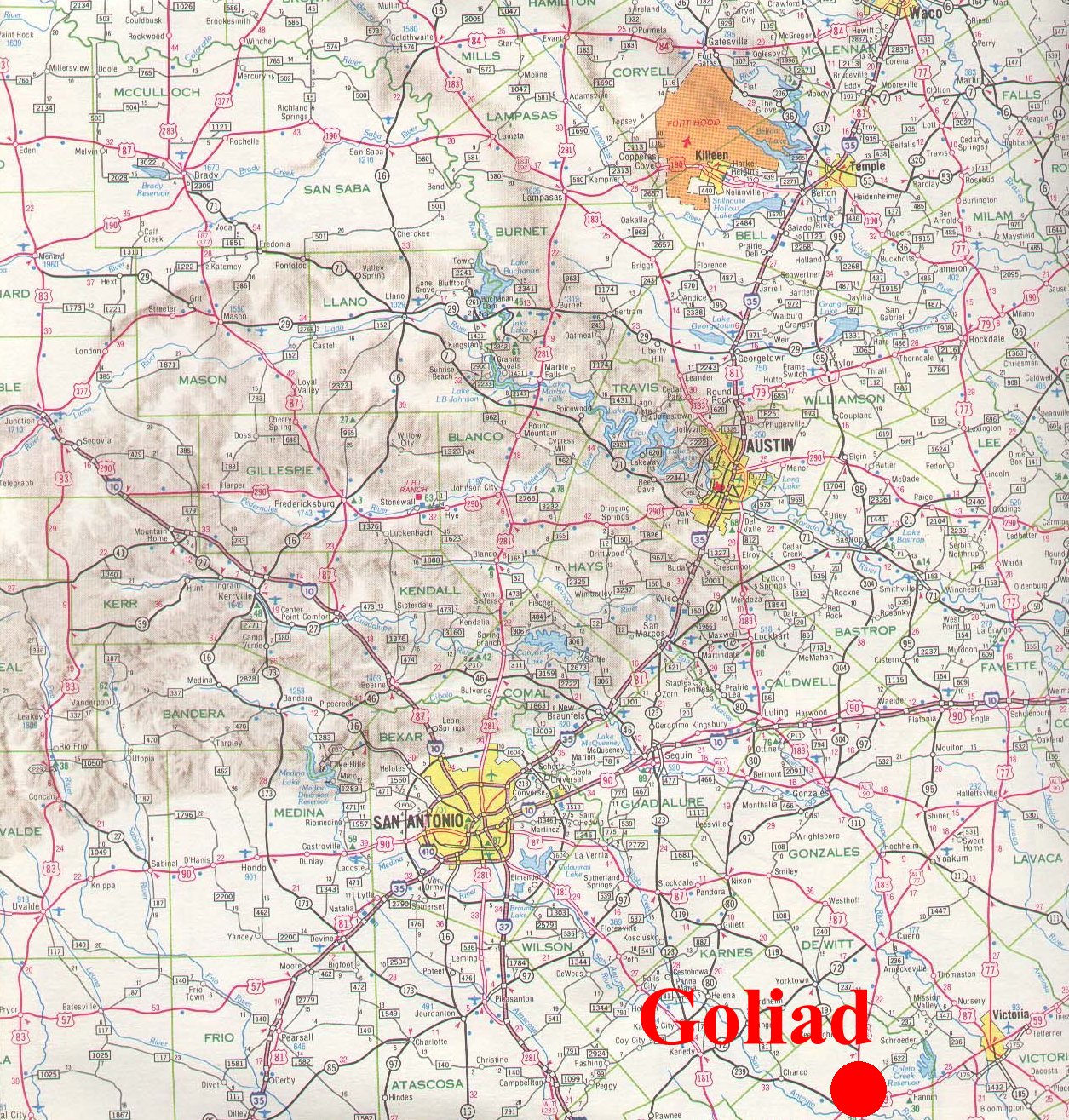

| Barbara Gutierrez | Fall 2000 |
| History 1302 | Hines |
The town centers around the Goliad County Courthouse, erected in 1894. Goliad's courthouse, along
with the 19th and early 20th century structures surrounding it was entered on the National Register
of Historic Places in 1976. The second empire style courthouse was designed by noted Texas
architect Alfred Giles and was completed in 1894. Limestone was used in the construction and
was hauled from Austin by oxcart. It was enlarged and restored in 1964 and is a recorded Texas
Historic Landmark.
A cyclone, considered one of the two most disastrous in Texas history, struck Goliad on Sunday May 18,
1902.
The twister touched down on the southside of the San Antonio River. The storm ripped a mile
long, half-mile wide path across the northwest section of the town, destroying over 100 homes and
leaving an official death toll of 114. The people were buried in one long trench, for there was
no time to dig seperate graves or conduct individual funerals. Damage was estimated at about $25,000.
After the disaster, the Goliad County Courthouse served as a temporary hospital and morgue.
For decades to come, this was noted as the state's worst tornado catastrophe.
The Goliad State Park features restored Mission Nuestra Senora del Espiritu Santo de Zuniga, generally
called Mission Espiritu Santo. By the early 18th century, when Spanish missionaries and soldiers
arrived in the mid-coastal area of Texas, the Karankawan and Coahuiltecan peoples had long occupied
the area. The Mission Espiritu Santo was founded in 1722 near Matagorda Bay to serve the Karankawa
Indians and their allies.
Designated a National Historic Landmark and considered the world's finest example of a Spanish
frontier fort, Presidio La Bahia was first founded on the banks of Garcitas Creek, near Lavaca
Bay. It has been owned by the Catholic Church since 1853 and is currently operated by the
Diocese of Victoria. The Presidio was relocated to its present location in 1749. Presidio
La Bahia is the oldest fort in the western United States, and the only Texas Revolution site
with its original 1836 appearance.
Nine flags of different nations have flown over the Presidio.
One of its historical backgrounds is being the place where the first Declaration of Texas
Independance was signed on December 20, 1835. The saddest page of Texas history, the Goliad
Massacre, which was the largest single loss of life in the cause of Texas Independance occurred
here. This event inspired the battle cry "Remember Goliad," at the battle of San Jacinto.
Both a state park and international historic site, reconstructed birthplace and statue of one of
Mexico's most famous military figures, General Ignacio Zaragoza (1829-1862), born in Goliad.
The Mexican general and liberal leader was minister of war under Juarez. In 1862 he commanded
an outnumbered and poorly equiped Mexican army in defense of the Central Mexico city of Puebla
against elite French forces.
Nine miles east of Goliad on Highway 59 is the site of the Battle of Coleto Creek. In March 1836,
during the Texas Revolution, Texas troops under Col. James Fannin surrendered here to superior Mexican
forces after a day and a half of fighting. Col. Fannin was one of the wounded individuals from
the battle of Coleto Creek. He was helped out of the chapel where the prisoners and wounded had
been held for a week.
 Goliad is located on the San Antonio River in South Texas at the intersection of US Highway
183 and 59. The town is primarily based on oil, agribusiness, and cattle, but tourism is also
a vital component. The moderate climate provides habitat for a variety of wildlife and rich
grasslands for ranching. Landscape is an important historical resource, from the plants and
animals that thrive there to modern day roadways that follow centuries-old trade routes.
Giant oak trees dominate the grassy landscape which traditionally were given to grazing herds
of cattle and horses. The San Antonio River flows through Goliad. Goliad has many historical
sites including the birthplace of the Mexican patriot Ignacio Zaragoza (hero of Cinco de Mayo),
the Mission Nuestra Senora del Rosario, and the restored Mission Nuestra Senora del Espiritu
Santo de Zuniga, plus many more. The two most controversial episodes of the entire Texas
Revolution are the Fannin Battleground at nearby Coleto Creek, and Nuestra Senora de Loreto presidio
(called Presidio La Bahia), site of the Goliad Massacre on Palm Sunday, March 27, 1836.
Goliad is located on the San Antonio River in South Texas at the intersection of US Highway
183 and 59. The town is primarily based on oil, agribusiness, and cattle, but tourism is also
a vital component. The moderate climate provides habitat for a variety of wildlife and rich
grasslands for ranching. Landscape is an important historical resource, from the plants and
animals that thrive there to modern day roadways that follow centuries-old trade routes.
Giant oak trees dominate the grassy landscape which traditionally were given to grazing herds
of cattle and horses. The San Antonio River flows through Goliad. Goliad has many historical
sites including the birthplace of the Mexican patriot Ignacio Zaragoza (hero of Cinco de Mayo),
the Mission Nuestra Senora del Rosario, and the restored Mission Nuestra Senora del Espiritu
Santo de Zuniga, plus many more. The two most controversial episodes of the entire Texas
Revolution are the Fannin Battleground at nearby Coleto Creek, and Nuestra Senora de Loreto presidio
(called Presidio La Bahia), site of the Goliad Massacre on Palm Sunday, March 27, 1836.

 On the north courthouse lawn there is a tree called "The Hanging Tree." At various times between
1846 and 1870, this tree served as the site of court sessions. Death sentences pronounced by
the court were carried out immediately with a rope and a strong limb. During the 1857 Cart War,
in which Texan freighters perpetrated a series of vicious attacks against Mexican cart drivers
along the Indianola-Goliad-San Antonio Road, this site witnessed a number of unauthorized lynchings
before the conflict was brought to an end by Texas rangers. Approximately 70 men lost their lives
during the conflict, some of them on this tree.
On the north courthouse lawn there is a tree called "The Hanging Tree." At various times between
1846 and 1870, this tree served as the site of court sessions. Death sentences pronounced by
the court were carried out immediately with a rope and a strong limb. During the 1857 Cart War,
in which Texan freighters perpetrated a series of vicious attacks against Mexican cart drivers
along the Indianola-Goliad-San Antonio Road, this site witnessed a number of unauthorized lynchings
before the conflict was brought to an end by Texas rangers. Approximately 70 men lost their lives
during the conflict, some of them on this tree.
 The indians abandoned the mission in 1724, and two years later the missionaries
moved to Mission Valley near Victoria which was in the territory of the Aranama and Tamique Indians.
In 1749, the mission was relocated to its present site on the San Antonio River near modern Goliad.
Mission Espiritu Santo, the first large cattle ranch in Texas, was granted jurisdiction over all
land between the Guadalupe and San Antonio Rivers as far north as Capote Hills near Gonzales.
On this land grazed the Missions's cattle herds which soon grew to number 40,000 herds.
Espiritu Santo existed as a mission for 110 years, longer than any other Spanish colonial mission
in Texas. In 1848, the Goliad City Council rebuilt the principal structures for use as public
school facilities. Later it became Aranama College, the first institution in Texas established
for education of Spanish-speaking Texans. The college for men lasted until the outbreak of the
Civil War when the student body marched off to join the Confederate Army.
The indians abandoned the mission in 1724, and two years later the missionaries
moved to Mission Valley near Victoria which was in the territory of the Aranama and Tamique Indians.
In 1749, the mission was relocated to its present site on the San Antonio River near modern Goliad.
Mission Espiritu Santo, the first large cattle ranch in Texas, was granted jurisdiction over all
land between the Guadalupe and San Antonio Rivers as far north as Capote Hills near Gonzales.
On this land grazed the Missions's cattle herds which soon grew to number 40,000 herds.
Espiritu Santo existed as a mission for 110 years, longer than any other Spanish colonial mission
in Texas. In 1848, the Goliad City Council rebuilt the principal structures for use as public
school facilities. Later it became Aranama College, the first institution in Texas established
for education of Spanish-speaking Texans. The college for men lasted until the outbreak of the
Civil War when the student body marched off to join the Confederate Army.
 This fort is where Goliad's history began. When the Spanish
arrived here in 1749, they found evidence of an Indian village in the area they named Santa Dorotea.
As a permanent settlement by Spain began, the name was changed to La Bahia meaning "The Bay." The Spaniards used the fort as protection. This became the original Goliad, the name being changed in 1829 as an anagram for Hidalgo. It was named in honor of the patriot priest of the Mexican Revolution, Father Miguel Hidalgo, who sounded the famous "Grito de Dolores" in 1810 for Mexican Independence from Spain.
This fort is where Goliad's history began. When the Spanish
arrived here in 1749, they found evidence of an Indian village in the area they named Santa Dorotea.
As a permanent settlement by Spain began, the name was changed to La Bahia meaning "The Bay." The Spaniards used the fort as protection. This became the original Goliad, the name being changed in 1829 as an anagram for Hidalgo. It was named in honor of the patriot priest of the Mexican Revolution, Father Miguel Hidalgo, who sounded the famous "Grito de Dolores" in 1810 for Mexican Independence from Spain.
 Zaragoza flung back the attacking army, inflicting heavy losses
and forcing its withdrawl to the east coast. It is not generally known that this French army
had proposed to march into Texas to establish aid and a supply line to Confederate forces.
The battle date, Cinco de Mayo (May 5), is a national holiday throughout Mexico, and is celebrated
in Goliad and in several Texas cities. In 1992, Goliad was named the State of Texas Official
Celebration Site for Cinco de Mayo.
Zaragoza flung back the attacking army, inflicting heavy losses
and forcing its withdrawl to the east coast. It is not generally known that this French army
had proposed to march into Texas to establish aid and a supply line to Confederate forces.
The battle date, Cinco de Mayo (May 5), is a national holiday throughout Mexico, and is celebrated
in Goliad and in several Texas cities. In 1992, Goliad was named the State of Texas Official
Celebration Site for Cinco de Mayo.
 On Palm Sunday, March 2,1836 the men were led out in three directions from
La Bahia and massacred; the wounded were shot in the compound of the fort. The bodies were stripped
and left unburied. When the shooting ended, 302 men were dead and about 28 escaped. Fannin and
39 other men who were wounded at the battle of Coleto Creek the week before the massacre were
killed inside the Presidio, bringing the total killed to 342. A monument marks the grave of
Colonel Fannin and 342 men who had surrendered to Mexican forces during the Texan Revolution and
massacred at the orders of General Santa Anna.
On Palm Sunday, March 2,1836 the men were led out in three directions from
La Bahia and massacred; the wounded were shot in the compound of the fort. The bodies were stripped
and left unburied. When the shooting ended, 302 men were dead and about 28 escaped. Fannin and
39 other men who were wounded at the battle of Coleto Creek the week before the massacre were
killed inside the Presidio, bringing the total killed to 342. A monument marks the grave of
Colonel Fannin and 342 men who had surrendered to Mexican forces during the Texan Revolution and
massacred at the orders of General Santa Anna.


ANNOTATED BIBLIOGRAPHY:
Craig H. Roell. "Remember Goliad" 1994 Texas State Historical Association, Austin, Tx.
The book gave information about the Goliad Massacre. Why Col. Fannin and his men who surrendered
to Mexican forces during the Texas Revolution were massacred at the order of Santa Anna.
Goliad County Historical Commission, "The History and Heritage of Goliad County" ed. Jakie L. Pruett
and Everett B. Cole. (Austin: Eakin, 1983).
Information about James W. Fannin, the controversial commander of Fort Difiance (La Bahia) at Goliad
in the Texas Revolution. The area is now Fannin Battlefield State Park.
Kathryn Stoner O'Connor, "The Presidio La Bahia del Espiritu Santo de Zuniga, 1721 to 1846."
(Austin: Von Boeckmann-Jones, 1966).
The oldest fort in the western United States and the only Texas Revolution site with its original
1836 appearance. The Mission Espiritu Santo founded in 1722 to serve the Caraway Indians.
Information is given about these two historical places. It is located in the Goliad State Park.
Irene Hohmann Friedrichs, "History of Goliad" (Victoria, Texas: Regal Printers, 1961: 2nd ed. 1967).
The book gives information about the different historical sites. What happen at these sites and
what they are now.
Snowden D. Flora, "Tornadoes of the United States". (Norman: University of Oklahoma Press, 1953).
The tornado of 1902 that destroyed the town of Goliad without warning. What the damages were and
how for decades to come, this was noted as the state's worst tornado catastrophe.
Mission Espiritu Santo: "Exploring the Past" (Austin: Texas Parks and Wildlife Department, April 1978).
Information about the mission, the operating of a large cattle ranch and the buildings used for
educational purposes.
Dudley Goodall Wooten, ed., "A Comprehensive History of Texas". (2 vols., Dallas:Scarff, 1898;
rpt., Austin: Texas State Historical Association, 1986).
Information about the fort La Bahia, literally meaning "the bay". The saddest page of Texas history
occured here, the Goliad Massacre.
Johanna M. Hunzkiker and Anna A. Fox, "Archeological Testing at Goliad State Park", (The University
of Texas at San Antonio, 1998).
Findings of small pieces used by the Indians at the Mission Espiritu Santo, from arrowheads to eating
utensils.
Personal Interview with Rachel Wagner at Goliad, Texas 2000.
Information about the town, the historical sites, the tours, and the fiestas and celebrations that are
celebrated in Goliad.
The New Handbook of Texas. vol.4 Austin: The Texas State Historical Association.
Basic information about the town of Goliad, such as population and historical sites.
Return to